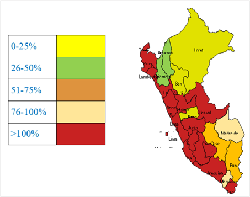Overcrowding in Peruvian prisons
an urgent problem
DOI:
https://doi.org/10.51252/rcri.v3i2.515Keywords:
crime, detention, criminals, overcrowding, INPE, Peru, prisonAbstract
The Latin American judicial system is based on incarceration, in Peru the population has the perception that if the judicial system incarcerates more people, it is of good quality, this is due to the fact that in many occasions people with high rank or economic position have been released from prison on many occasions, seeing themselves as unpunished. Methodology: Cross-sectional study, the population consisted of inmates of the 69 prisons that exist in Peru registered in the database of the National Penitentiary Institute of Peru through its public database. The study did not require review by an ethics committee since the data are public. Results: as of December 2019, the national prison holding capacity is 40,137, however, the prison population was 95,548 (238%), there is 138% overcrowding. Conclusions: Prison overcrowding in Peru's prisons is a rampant problem that must be solved by implementing reforms in the judicial system, prison housing and control of infectious diseases.
Downloads
References
García-Guerrero, J., & Marco, A. (2012). Sobreocupación en los Centros Penitenciarios y su impacto en la salud. Revista Española de Sanidad Penitenciaria, 14(3), 106–113. https://doi.org/10.4321/S1575-06202012000300006
INPE. (2018). Módulo de Estadística. Instituto Nacional Penitenciario. https://www.inpe.gob.pe/estadística1.html
Jürgens, R., Nowak, M., & Day, M. (2011). HIV and incarceration: prisons and detention. Journal of the International AIDS Society, 14(1), 26–26. https://doi.org/10.1186/1758-2652-14-26
Legrand, J., Sanchez, A., Le Pont, F., Camacho, L., & Larouze, B. (2008). Modeling the Impact of Tuberculosis Control Strategies in Highly Endemic Overcrowded Prisons. PLoS ONE, 3(5), e2100. https://doi.org/10.1371/journal.pone.0002100
Lester, D. (1990). Overcrowding in prisons and rates of suicide and homicide. Perceptual and Motor Skills, 71(1), 274. https://pubmed.ncbi.nlm.nih.gov/2235269/
Levitt, S. D. (1996). The Effect of Prison Population Size on Crime Rates: Evidence from Prison Overcrowding Litigation. The Quarterly Journal of Economics, 111(2), 319–351. https://doi.org/10.2307/2946681
Magán Zevallos, J. C. (2016). Overcrowding in the Peruvian prison system. International Review of the Red Cross, 98(903), 851–858. https://doi.org/10.1017/S1816383117000649
Ministerio de Justicia y Derechos Humanos. (2015). Infraestructura Penitenciaria. Proyección de la Capacidad de Albergue 2015 - 2035. In Dirección General de Política Criminal y Penitenciaria (1st ed.).
Sharkey, L. (2010). Does Overcrowding in Prisons Exacerbate the Risk of Suicide among Women Prisoners? The Howard Journal of Criminal Justice, 49(2), 111–124. https://doi.org/10.1111/j.1468-2311.2009.00602.x
Walmsley, R. (2016). World Prison Population List. In World Prison Brief - Institute for Criminal Policy Research (11th ed.).
Zampa, F. (1991). Some Effects Of Extreme Overcrowding In Peruvian Prisons*. Criminal Justice Policy Review, 5(2), 133–141. https://doi.org/10.1177/088740349100500205

Published
How to Cite
Issue
Section
License
Copyright (c) 2023 Sebastian Iglesias-Osores, Johana Acosta-Quiroz

This work is licensed under a Creative Commons Attribution 4.0 International License.
The authors retain their rights:
a. The authors retain their trademark and patent rights, as well as any process or procedure described in the article.
b. The authors retain the right to share, copy, distribute, execute and publicly communicate the article published in the Ratio Iure Scientific Journal (RCRI) (for example, place it in an institutional repository or publish it in a book), with an acknowledgment of its initial publication in the RCRI.
c. Authors retain the right to make a subsequent publication of their work, to use the article or any part of it (for example: a compilation of their works, notes for conferences, thesis, or for a book), provided that they indicate the source of publication (authors of the work, journal, volume, number and date).






